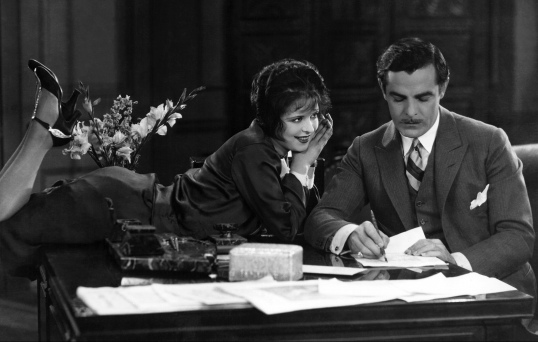(Spoilers below)
If I could be any character from a silent film, I would want to be Betty Lou Spence, the heroine of the classic 1927 film, It.
As played by the beautiful Clara Bow, Betty has It. What is It, you may ask? That’s the question that this film sets out to answer. The movie starts out with a title card that read, “That quality possessed by some which draws all others with its magnetic force. With ‘It’ you win all men if you are a woman and all women if you are a man. ‘It’ can be a quality of the mind as well as a physical attraction.” Throughout the film, every man who sets his eyes on Betty automatically says that she has “it.” Though the film never explicitly says so, it’s pretty obvious that “It” is a combination of sensuality, intelligence, and inner strength.
It is sex.
And yes, since she’s played by Clara Bow, Betty Lou Spencer definitely has ‘it’ and she knows what to do with it as well.
However, one thing that Betty doesn’t have is a lot of money. Instead, she’s a proud and poor shopgirl who sets her sights on her wealthy and handsome employer, Cyrus Waltham (played by Antonio Moreno). Realizing that the uptight Cyrus will never notice her while at work, Betty accepts a date with Cyrus’s irresponsible best friend Monty (William Austin). Knowing that Cyrus and his girlfriend will also be there, Betty asks Monty to take her to a fancy restaurant. While Monty orders their food, Betty stares shocked at the high prices on the menu. Why just the appetizers cost $2.00!
Ah, 1927.
Eventually, Betty does manage to get Cyrus’s attention. After spending a day slumming with her down on Coney Island, Cyrus attempts to kiss Betty. Betty responds by slapping him and telling him, “So, you’re one of those minute men — the minute you meet a girl, you think you can kiss her!”
The next day, things get a bit more complicated when Betty discovers that two social workers have shown up at the apartment of her best friend, Molly (Priscilla Bonner). Molly is a single mother and the social workers have shown up to take away her baby. Betty boldly steps forward, claiming that she is the baby’s true mother and that, since she has a job, the social works have no reason to take away her baby.
One of the snooty social workers (who, needless to say, does not have it) stares down here nose at Betty and asks, “And where is your husband?”
Betty stares straight back at her and replies, “That’s none of your business.”
Seriously, nobody tells Betty Lou Spence what to do.
Since this movie was made in 1927, everyone is scandalized. Cyrus, obviously miffed that he couldn’t even get a kiss from an unwed mother, dumps her. Betty responds by quitting her job. A title card informs us that Betty may have needed the money but her pride was far more important to her. What makes this movie unique, especially when compared to even some contemporary films, is that Betty is not punished for putting her pride before money or romance. Instead, the film celebrates her independence.
The rest of the film deals with her getting her own brand of vengeance on Cyrus. In the end, Betty gets her man but she gets him on her own terms. Again, take a minute to consider that this film, made nearly 90 years ago, not only features a liberated woman but celebrates her as well.
After this film, Clara Bow became known as the “It Girl,” and it’s easy to see why. In the role of Betty Lou Spence, Bow epitomizes the perfect combination of outward sensuality and inward strength. Whether she’s sarcastically telling off a rude customer, defending her best friend, or saving the life of her romantic rival, Clara Bow epitomizes both sex and independence. In the end, she pursues her man not out of obligation but out of desire. When she does find her happy ending, she finds it on her own terms.
Those of us in 2013 have a lot to learn from the It Girl of 1927.

“Why just the appetizers cost $2.00! Ah, 1927.”
You know, two dollars back then was a lot of money! Being a shopgirl, Betty Lou Spence was probably only pulling down fifteen dollars a week—maybe even less than that given the wage inequity of the times. Things weren’t really “cheaper” back then. I suppose if you had a time machine and travelled from the year 1927 into the present day and found twenty dollars on the ground, then went back to 1927, you’d be a real Rockerfeller.
If you adore silent cinema, I recommend “The Docks of New York” (1928) most highly. I was most privileged to catch this at the picture theatre last year. Amazing how a film made more than eighty years ago can, from a visual standpont, totally overshadow countless films made these days.
LikeLike
Pingback: Embracing the Melodrama, Part II: Wings (dir by William Wellman) | Through the Shattered Lens
Pingback: Embracing the Melodrama Part II #41: Ciao! Manhattan (dir by John Palmer and David Weisman) | Through the Shattered Lens
Pingback: Here’s The Trailer For It! | Through the Shattered Lens
Pingback: Film Review: Factory Girl (dir by George Hickenlooper) | Through the Shattered Lens
Pingback: Lisa’s Week In Review — 5/7/2018 — 5/13/2018 | Through the Shattered Lens
Pingback: Lisa’s Week In Review: 7/23/18 — 7/29/18 | Through the Shattered Lens
Pingback: Lisa Marie’s Week In Review: 2/17/20 — 2/23/20 | Through the Shattered Lens
Pingback: Scenes That I Love: Clara Bow Prepares For Her Date In 1927’s It! | Through the Shattered Lens
Pingback: Film Review: Children of Divorce (dir by Frank Lloyd and Josef von Sternberg) | Through the Shattered Lens